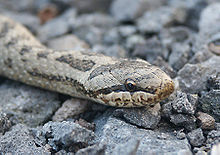Coronella austriaca
| Smooth snake | |
|---|---|
 |
|
| Scientific classification | |
| Kingdom: | Animalia |
| Phylum: | Chordata |
| Class: | Reptilia |
| Order: | Squamata |
| Suborder: | Serpentes |
| Family: | Colubridae |
| Genus: | Coronella |
| Species: | C. austriaca |
| Binomial name | |
|
Coronella austriaca Laurenti, 1768 |
|
 |
|
Coronella austriaca (commonly known as a smooth snake) is a non-venomous colubrid species found in northern and central Europe, but also as far east as northern Iran. The European Molecular Biology Laboratory (EMBL) currently recognizes three subspecies, including the typical form described here.
Both sexes grow to an average length of about 60 cm (24 in) to 75 cm (30 in). Two specimens measuring 83 cm (33 in) have been recorded in Sweden, as well as one in Russia that was 92 cm (36 in).
The head has a rostral scale that is at least as deep as it is wide, creating a triangular indentation between the internasal scales (rarely separating them). The top of the head is covered with nine large plates. The nasal scale is often divided. There is one (rarely two) preoculars and two . The temporals number 2+2 or 2+3 (rarely 1+2) . There are seven (rarely eight) upper labials, of which the third and fourth or fourth and fifth border the eye.
In the middle part of the body there are 19 (rarely 17 or 21) rows of dorsal scales. In contrast with many other snakes found in the region, these scales are flat (not keeled). This gives the snake a smooth texture to the touch, from which it gets its common name. The ventral scales number 150-164 in males and 162–200 in females. The anal scale is divided (rarely single) and the subcaudal scales are paired. Males have 54–70 subcaudal scales and females 40–76.
The colour pattern consists of a brown, grey or reddish ground colour with two rows of small, rather indistinct dark spots running down the back towards the tail. In some cases, each pair of spots may be united toward the neck area, forming a series of cross-bars over the back. There is also a very indistinct series of dark spots running along each of the flanks. These four series of spots along the body overlay four parallel, rather shadowy stripes that also run down the back and flanks.
...
Wikipedia
